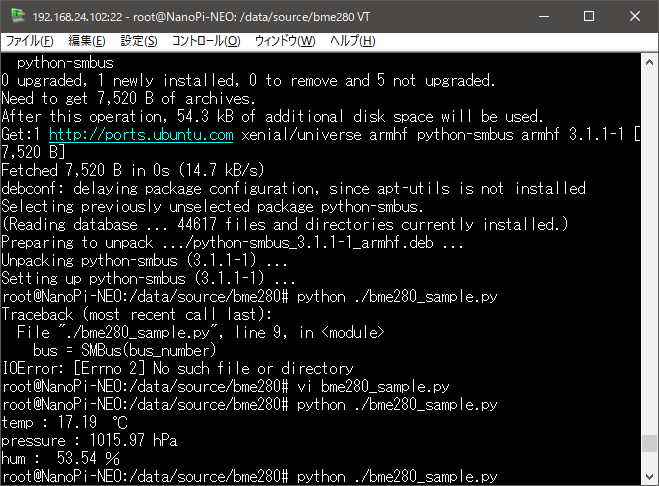さて、サンプルプログラムは動いたのですが。
これをどうやって使っていこうかと。
ま、温度計を組んでみて。
接続。

無事データ取れました(ってこれnanopiだけどね)。
まあデータは揃ってるので、表示部分どうにかしましょうか。
作戦としては、「数秒ごとに静止画を更新表示」でいこうかと。
で、「なるべく高密度に」。
要は64x32の画像を作って、それを送ってやればいいのです。
で、まず。
bmp回りをperlで解析実装。
bmpはまあ、56バイト目から、左下→右下積み上げで、RGBの順番でデータが入っています。
なのですっごく適当に実装すると、こんな感じ。
open (IN,$inputbitmapbackgroundfilename);
binmode (IN);
$buffersize = 1;
$count = 0;
$output = "";
undef (@bitmapoutputbase);
$colcount = 0;
$rowcount = 31;
while (){
$count++;
read(IN,$readdata,$buffersize);
if ($count < 55){next;}
if ($count > 20000){last;}
$readdata = unpack("H2",$readdata);
$rawcount = $rowcount * 64 * 3;
$rawcount += $colcount;
$bitmapoutputbase[$rawcount] = $readdata;
$colcount++;
if ($colcount > 191){
$rowcount--;
if ($rowcount < 0){last;}
$colcount = 0;
}
}
close (IN);
取り回しラクなように、バイナリから十六進に変換。
今回横幅64ドットなので、64x3な192カウント毎に縦32ライン分減算していき、左上原点な一次元配列に突っ込む感じで。
で、フォント検討。
情報なるべく表示したいので、まあ縦4の横16としますか。
すると、1つのフォントは、「8x4」になります。
ま、サックリ作製。

これを読み込ませて、フォントレンダラを作ってみます。
sub renderfont {
my $data = $_[0];
# 0123456789.ch:p-
# RDMぶけラ
$fontseed = "1:15";
if ($data eq " "){$fontseed = "1:15";}
if ($data eq "0"){$fontseed = "0:0";}
if ($data eq "1"){$fontseed = "0:1";}
if ($data eq "2"){$fontseed = "0:2";}
if ($data eq "3"){$fontseed = "0:3";}
if ($data eq "4"){$fontseed = "0:4";}
if ($data eq "5"){$fontseed = "0:5";}
if ($data eq "6"){$fontseed = "0:6";}
if ($data eq "7"){$fontseed = "0:7";}
if ($data eq "8"){$fontseed = "0:8";}
if ($data eq "9"){$fontseed = "0:9";}
if ($data eq "."){$fontseed = "0:10";}
if ($data eq "c"){$fontseed = "0:11";}
if ($data eq "h"){$fontseed = "0:12";}
if ($data eq ":"){$fontseed = "0:13";}
if ($data eq "p"){$fontseed = "0:14";}
if ($data eq "-"){$fontseed = "0:15";}
if ($data eq "R"){$fontseed = "1:0";}
if ($data eq "D"){$fontseed = "1:1";}
if ($data eq "M"){$fontseed = "1:2";}
if ($data eq "W"){$fontseed = "1:3";}
if ($data eq "w"){$fontseed = "1:4";}
if ($data eq "X"){$fontseed = "1:5";}
if ($data eq "x"){$fontseed = "1:6";}
if ($data eq "Y"){$fontseed = "1:7";}
if ($data eq "y"){$fontseed = "1:8";}
if ($data eq "Z"){$fontseed = "1:9";}
if ($data eq "z"){$fontseed = "1:10";}
$fontcolcount = 0;
$fontrowcount = 0;
@fontdataarray = $fontdata{$fontseed} =~ /.{2}/g;
foreach $ch (@fontdataarray) {
$fontrow = ($outputline * 8) + $fontrowcount;
$fontcol = ($outputcol * 4 * 3 ) + $fontcolcount;
$injectpointer = ($fontrow * 3 * 64) + $fontcol;
if ($ch ne "00"){
$bitmapoutputbase[$injectpointer] = $ch;
}
$fontcolcount++;
if ($fontcolcount > 11){
$fontrowcount++;
$fontcolcount = 0;
}
}
}
$outputlineと$outputcolをそれぞれ行と列を突っ込んで、データを関数呼び出しに渡してあげれば、bitmapoutputbaseな配列にレンダーする仕組みです。
RGBどれかが00の場合、元画像をそのまま出すステキ機能つき。
あとはまあ、テキストでデータ作るだけ。
こんな感じでね。
open (FILE,$humdatafilename1);
(@humdataarray) = (<FILE>);
close (FILE);
chomp($humdataarray[0]);
if ($humdataarray[0] < 0){
$j = abs(int ($humdataarray[0]));
$k = abs(int ($humdataarray[0] * 10));
$k = $k - ($j * 10);
$j = sprintf("%03d",$j);
$k = sprintf("%01d",$k);
$output_it = "-$j.$k";
}
else {
$j = abs(int ($humdataarray[0]));
$k = abs(int ($humdataarray[0] * 100));
$k = $k - ($j * 100);
$j = sprintf("%02d",$j);
$k = sprintf("%02d",$k);
$output_it = "$j.$k";
}
chomp($humdataarray[1]);
$j = abs(int ($humdataarray[1] / 100));
$k = abs(int ($humdataarray[1]));
$k = $k - ($j * 100);
$j = sprintf("%04d",$j);
$k = sprintf("%02d",$k);
$output_ip = "$j.$k";
chomp($humdataarray[2]);
$j = abs(int ($humdataarray[2]));
$k = abs(int ($humdataarray[2] * 100));
$k = $k - ($j * 100);
$j = sprintf("%02d",$j);
$k = sprintf("%02d",$k);
$output_ih = "$j.$k";
open (FILE,$humdatafilename2);
(@humdataarray) = (<FILE>);
close (FILE);
chomp($humdataarray[0]);
if ($humdataarray[0] < 0){
$j = abs(int ($humdataarray[0]));
$k = abs(int ($humdataarray[0] * 10));
$k = $k - ($j * 10);
$j = sprintf("%03d",$j);
$k = sprintf("%01d",$k);
$output_ot = "-$j.$k";
}
else {
$j = abs(int ($humdataarray[0]));
$k = abs(int ($humdataarray[0] * 100));
$k = $k - ($j * 100);
$j = sprintf("%02d",$j);
$k = sprintf("%02d",$k);
$output_ot = "$j.$k";
}
chomp($humdataarray[1]);
$j = abs(int ($humdataarray[1] / 100));
$k = abs(int ($humdataarray[1]));
$k = $k - ($j * 100);
$j = sprintf("%04d",$j);
$k = sprintf("%02d",$k);
$output_op = "$j.$k";
chomp($humdataarray[2]);
$j = abs(int ($humdataarray[2]));
$k = abs(int ($humdataarray[2] * 100));
$k = $k - ($j * 100);
$j = sprintf("%02d",$j);
$k = sprintf("%02d",$k);
$output_oh = "$j.$k";
#tokoyami
$timenow = time;
$timeseed = $timenow - 1510434000;
$timeseed = int ($timeseed / 86400);
$timeseed %= 4;
if ($timeseed == 0){($toko_r,$toko_d,$toko_m) = (1,3,2);}
if ($timeseed == 1){($toko_r,$toko_d,$toko_m) = (2,4,3);}
if ($timeseed == 2){($toko_r,$toko_d,$toko_m) = (3,1,4);}
if ($timeseed == 3){($toko_r,$toko_d,$toko_m) = (4,2,1);}
#boueigun
$timenow = time;
$timeseed = $timenow - 1510434000;
$timeseed = int ($timeseed / 3600);
$timeseed %= 7;
if ($timeseed == 0){($defe_i,$defe_j) = ("Yy","Yy");}
if ($timeseed == 1){($defe_i,$defe_j) = ("Yy","Ww");}
if ($timeseed == 2){($defe_i,$defe_j) = ("Ww","Ww");}
if ($timeseed == 3){($defe_i,$defe_j) = ("Ww","Xx");}
if ($timeseed == 4){($defe_i,$defe_j) = ("Xx","Xx");}
if ($timeseed == 5){($defe_i,$defe_j) = ("Xx","Zz");}
if ($timeseed == 6){($defe_i,$defe_j) = ("Zz","Yy");}
(@date) = localtime (time);
$time_format = sprintf("%02d:%02d",$date[2],$date[1]);
$dataone = " " .$output_it."c ".$output_ot."c";
$datatwo = " " .$output_ih."p ".$output_oh."p";
$datathr = $output_ip."h".$output_op."h";
$datafou = "R".$toko_r."D".$toko_d."M".$toko_m." ".$defe_i.$defe_j.$time_format;
別途cronで回している、温度計データを2ch分取得し適当演算、上から、温度、湿度、気圧と並べてます。
1行余ったので、某ドラクエ10の、常闇だの防衛軍と、時刻を表示って感じ。
テキストベースで出力は、こんな感じになりますよ、と。
20.67c 20.76c
49.66p 46.20p
1018.28h 1016.46h
R3D1M4 YyZz 18:03
で、bmp出力部。
ヘッダは固定でいいやってね。
$bitmapoutput = "424d361800000000000036000000280000004000000020000000010018000000000000180000120b0000120b00000000000000000000";
for $i (0..31){
for $j (0..63){
for $k (0..2){
$bitmappointer = (( 31 - $i ) * 64 + $j) * 3 + $k;
$bitmapoutput .= $bitmapoutputbase[$bitmappointer];
}
}
}
$bitmapbinary = pack("H*",$bitmapoutput);
open (OUTPUT,">$outputfilename");
binmode(OUTPUT);
print OUTPUT $bitmapbinary;
close (OUTPUT);
ま、出力例1、背景黒だとこんな感じ。
フォントには影つけてます。

さ、次は、実際に表示してみますかね。
